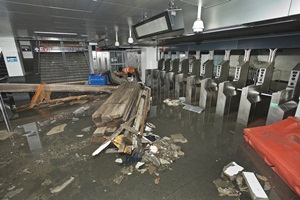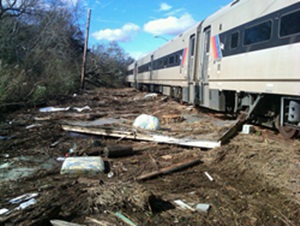|
Hurricane Sandy, the largest tropical storm on record, slammed into the Eastern seaboard this week, creating major damage to public transportation infrastructure in New York, New Jersey, and Connecticut, and wreaking havoc with system operations.
The world has seen the images: power lines strewn like toothpicks across railroad tracks; New York City subways inundated with both sea and rainwater; boats sitting on top of an upstate New York train track and in front yards; and Atlantic City’s famed Boardwalk reduced to a pile of lumber.
Before Sandy was forecast to hit, public transportation agencies in the path of the storm took the unprecedented step of shutting down service.
The Federal Emergency Management Agency (FEMA) has agreed to provide full funding for public transportation and power restoration efforts in New York and New Jersey in the aftermath of Hurricane Sandy, through Nov. 9.
“This was not a New York disaster, or a New Jersey disaster or a Connecticut disaster, but a national disaster, and FEMA and the federal government should be providing help to the region to the full extent they can,” said Sen. Charles Schumer (D-NY) in a Nov. 1 statement.
“APTA and our industry partners extend our sympathies to those who suffered losses as a result of Hurricane Sandy. At the same time, we are so proud of how the transit industry, public, private, and federal partners alike, have pulled together to offer support and assistance to those systems that have been adversely impacted. The dedication, skills, and hard work demonstrated by countless workers pumping out flooded stations; figuring out how to remove boats, trucks, and debris from rail lines; and the many other tasks too numerous to delineate are nothing short of heroic. Once again, public transportation has shown how critical it is to our cities and our economy, and how truly outstanding the people are that make these systems work day in and day out,” said APTA President & CEO Michael Melaniphy.
As Passenger Transport went to press, NYC Transit had begun providing limited subway service along segments of roughly half of the system’s 23 lines. Because of the lack of electricity to power the third rail or to operate signals south of 36th Street in Manhattan, subways cannot operate between 34th Street and downtown Brooklyn. Limited bus service resumed the evening of Oct. 30 and has returned to near-normal levels. Both LIRR and Metro-North restored limited service Oct. 31.
MTA Chairman and Chief Executive Officer Joseph J. Lhota said the damage the hurricane caused to the 108-year-old subway system was the worst in its history. During a press briefing, he stated: “Sandy wreaked havoc on the entire transportation system—the subways, the buses, Metro-North, and Long Island Rail Road—in every single borough of the city and every single county in the MTA region.”
NJ Transit canceled all service Oct. 28 as the storm approached. At that time, agency personnel moved locomotives, train cars, buses, and other equipment to locations where they could be protected as much as possible from the storm.
Since the storm subsided the morning of Oct. 30, NJ Transit crews have worked around the clock to inspect more than 500 miles of track, equipment yards, buses, and train sets, making repairs or cleanups where necessary as the first step toward restoring service to normal operations.
However, according to an NJ Transit statement: “Hurricane Sandy caused major damage throughout the state, leaving behind long-term mechanical and operational challenges that NJ Transit is working tirelessly to overcome. This will take time, and the blow delivered by Hurricane Sandy will continue to impact customers for days to come.” As of press time, most bus service was restored at NJ Transit.
Connecticut Transit (CTTransit) shut down service for an entire business day on Oct. 29—“for the first time that any of us can remember,” according to General Manager David Lee.
“We reopened Hartford at noon on Tuesday [Oct. 30],” Lee added, “while New Haven and Stamford remained closed. As of Wednesday [Oct. 31], service had returned to normal with sizeable detours in New Haven and Stamford as the cities deal with storm debris.”
He noted that, while “coastal Connecticut has taken as bad a beating as they have ever seen,” the aftermath of the storm is not as severe as in New York City.
|

|

|

|
|
Hurricane Sandy brought flood waters and debris into NYC Transit's South Ferry Station. |
An NJ Transit train stands on the tracks, surrounded by debris spread by the heavy rain and high winds of Hurricane Sandy. |
Water inundates the Port Authority Trans-Hudson Corporation (PATH) station in Hoboken, NJ. As Passenger Transport went to press, PATH service had been suspended until further notice. |
| 






